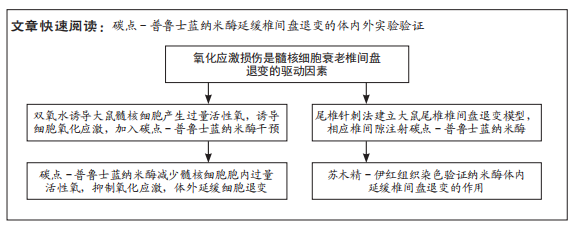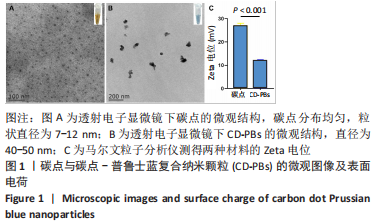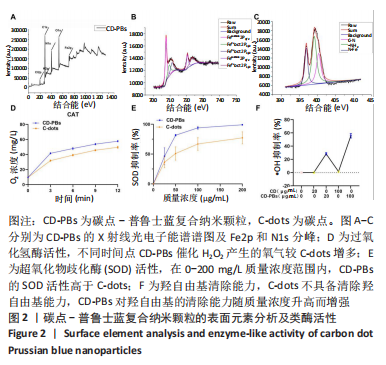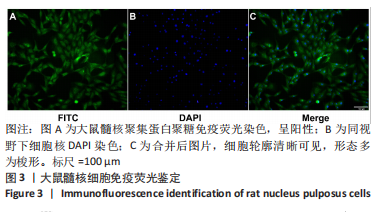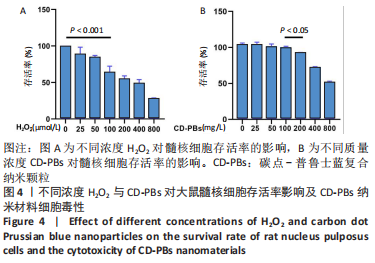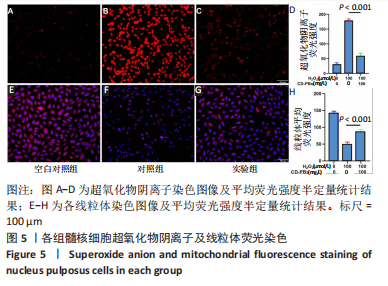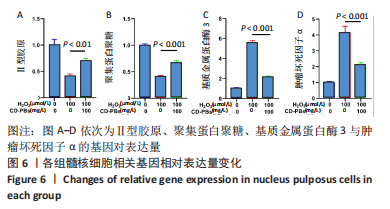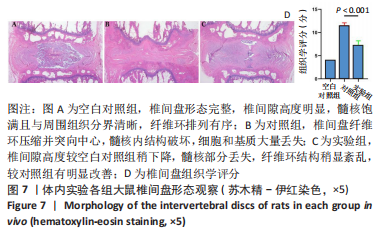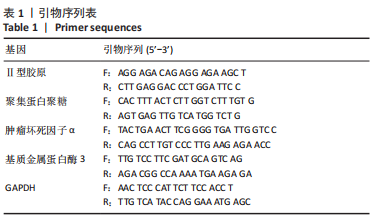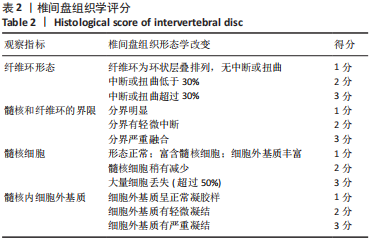[1] EKRAM S, KHALID S, SALIM A, et al. Regulating the fate of stem cells for regenerating the intervertebral disc degeneration. World J Stem Cells. 2021;13(12):1881-1904.
[2] ISA ILM, MOKHTAR SA, ABBAH SA, et al. Intervertebral Disc Degeneration: Biomaterials and Tissue Engineering Strategies Towards Precision Medicine. Adv Healthc Mater. 2022;11(13):e2102530.
[3] ZHANG GZ, LIU MQ, CHEN HW, et al. NF-κB signalling pathways in nucleus pulposus cell function and intervertebral disc degeneration. Cell Prolif. 2021;54(7):e13057.
[4] FENG C, YANG M, LAN M, et al. ROS: Crucial Intermediators in the Pathogenesis of Intervertebral Disc Degeneration. Oxid Med Cell Longev. 2017;2017:5601593.
[5] APEL K, HIRT H. Reactive oxygen species: metabolism, oxidative stress, and signal transduction. Annu Rev Plant Biol. 2004;55:373-399.
[6] LENNICKE C, COCHEMé HM. Redox metabolism: ROS as specific molecular regulators of cell signaling and function. Mol Cell. 2021; 81(18):3691-3707.
[7] CAO G, YANG S, CAO J, et al. The Role of Oxidative Stress in Intervertebral Disc Degeneration. Oxid Med Cell Longev. 2022;2022: 2166817.
[8] CORMODE DP, GAO L, KOO H. Emerging Biomedical Applications of Enzyme-Like Catalytic Nanomaterials. Trends Biotechnol. 2018;36(1): 15-29.
[9] AN Z, YAN J, ZHANG Y, et al. Applications of nanomaterials for scavenging reactive oxygen species in the treatment of central nervous system diseases. J Mater Chem B. 2020;8(38):8748-8767.
[10] DIXON AR, WARREN JP, CULBERT MP, et al. Review of in vitro mechanical testing for intervertebral disc injectable biomaterials. J Mech Behav Biomed Mater. 2021;123:104703.
[11] ÐORĐEVIĆ L, ARCUDI F, PRATO M. Preparation, functionalization and characterization of engineered carbon nanodots. Nat Protoc. 2019; 14(10):2931-2953.
[12] LI X, ZHAO S, LI B, et al. Advances and perspectives in carbon dot-based fluorescent probes: Mechanism, and application. Coord Chem Rev. 2021;431:213686.
[13] WANG H, LIU C, LIU Z, et al. Specific Oxygenated Groups Enriched Graphene Quantum Dots as Highly Efficient Enzyme Mimics. Small. 2018;14(13):e1703710.
[14] LI F, LI T, SUN C, et al. Selenium-Doped Carbon Quantum Dots for Free-Radical Scavenging. Angew Chem Int Ed Engl. 2017;56(33):9910-9914.
[15] RIZZO C, ARCUDI F, ĐORĐEVIĆ L, et al. Nitrogen-Doped Carbon Nanodots-Ionogels: Preparation, Characterization, and Radical Scavenging Activity. ACS Nano. 2018;12(2):1296-1305.
[16] ZHANG W, ZHANG Y, CHEN Y, et al. Prussian blue modified ferritin as peroxidase mimetics and its applications in biological detection. J Nanosci Nanotechnol. 2013;13(1):60-67.
[17] ZHANG W, MA D, DU J. Prussian blue nanoparticles as peroxidase mimetics for sensitive colorimetric detection of hydrogen peroxide and glucose. Talanta. 2014;120:362-367.
[18] ESTELRICH J, BUSQUETS MA. Prussian Blue: A Nanozyme with Versatile Catalytic Properties. Int J Mol Sci. 2021;22(11):5993.
[19] WANG H, CHENG L, MA S, et al. Self-Assembled Multiple-Enzyme Composites for Enhanced Synergistic Cancer Starving-Catalytic Therapy. ACS Appl Mater Interfaces. 2020;12(18):20191-20201.
[20] BIAN J, CAI F, CHEN H, et al. Modulation of Local Overactive Inflammation via Injectable Hydrogel Microspheres. Nano Lett. 2021; 21(6):2690-2698.
[21] MASUDA K, AOTA Y, MUEHLEMAN C, et al. A novel rabbit model of mild, reproducible disc degeneration by an anulus needle puncture: correlation between the degree of disc injury and radiological and histological appearances of disc degeneration. Spine (Phila Pa 1976). 2005;30(1):5-14.
[22] JI ML, JIANG H, ZHANG XJ, et al. Preclinical development of a microRNA-based therapy for intervertebral disc degeneration. Nat Commun. 2018;9(1):5051.
[23] NASTO LA, ROBINSON AR, NGO K, et al. Mitochondrial-derived reactive oxygen species (ROS) play a causal role in aging-related intervertebral disc degeneration. %J Journal of Orthopaedic Research. J Orthop Res. 2013;31(7):1150-1157.
[24] DIMOZI A, MAVROGONATOU E, SKLIROU A, et al. Oxidative stress inhibits the proliferation, induces premature senescence and promotes a catabolic phenotype in human nucleus pulposus intervertebral disc cells. Eur Cell Mater. 2015;30:89-102.
[25] WANG J, XIA D, LIN Y, et al. Oxidative stress-induced circKIF18A downregulation impairs MCM7-mediated anti-senescence in intervertebral disc degeneration. Exp Mol Med. 2022;54(3):285-297.
[26] QUINLAN CL, PEREVOSHCHIKOVA IV, HEY-MOGENSEN M, et al. Sites of reactive oxygen species generation by mitochondria oxidizing different substrates. Redox Biol. 2013;1:304-312.
[27] ZIEGLER DV, WILEY CD, VELARDE MC. Mitochondrial effectors of cellular senescence: beyond the free radical theory of aging. Aging Cell. 2015; 14(1):1-7.
[28] QI JH, DONG FX. The relevant targets of anti-oxidative stress: a review. J Drug Target. 2021;29(7):677-686.
[29] JUAN CA, PéREZ DE LA LASTRA JM, PLOU FJ, et al. The Chemistry of Reactive Oxygen Species (ROS) Revisited: Outlining Their Role in Biological Macromolecules (DNA, Lipids and Proteins) and Induced Pathologies. Int J Mol Sci. 2021;22(9):4642.
[30] XU X, WANG D, ZHENG C, et al. Progerin accumulation in nucleus pulposus cells impairs mitochondrial function and induces intervertebral disc degeneration and therapeutic effects of sulforaphane. Theranostics. 2019;9(8):2252-2267.
[31] YANG L, RONG Z, ZENG M, et al. Pyrroloquinoline quinone protects nucleus pulposus cells from hydrogen peroxide-induced apoptosis by inhibiting the mitochondria-mediated pathway. Eur Spine J. 2015;24(8): 1702-1710.
[32] KANG L, LIU S, LI J, et al. The mitochondria-targeted anti-oxidant MitoQ protects against intervertebral disc degeneration by ameliorating mitochondrial dysfunction and redox imbalance. Cell Prolif. 2020;53(3): e12779.
[33] DAI S, SHI X, QIN R, et al. Sodium Tanshinone IIA Sulfonate Ameliorates Injury-Induced Oxidative Stress and Intervertebral Disc Degeneration in Rats by Inhibiting p38 MAPK Signaling Pathway. Oxid Med Cell Longev. 2021;2021:5556122.
[34] SEOL D, COLEMAN MC, MARTIN JA, et al. Targeting Oxidative Stress with Amobarbital to Prevent Intervertebral Disc Degeneration. Spine J. 2021;21(6):1021-1030.
[35] LIN J, DU J, WU X, et al. SIRT3 mitigates intervertebral disc degeneration by delaying oxidative stress-induced senescence of nucleus pulposus cells. J Cell Physiol. 2021;236(9):6441-6456.
[36] ZHAO H, ZHANG R, YAN X, et al. Superoxide dismutase nanozymes: an emerging star for anti-oxidation. J Mater Chem B. 2021;9(35):6939-6957.
[37] GAO L, ZHUANG J, NIE L, et al. Intrinsic peroxidase-like activity of ferromagnetic nanoparticles. Nat Nanotechnol. 2007;2(9):577-583.
[38] REN X, CHEN D, WANG Y, et al. Nanozymes-recent development and biomedical applications. J Nanobiotechnol. 2022;20(1):92.
[39] LIU X, GAO Y, CHANDRAWATI R, et al. Therapeutic applications of multifunctional nanozymes. Nanoscale. 2019;11(44):21046-21060.
[40] CHEN R, LIU G, SUN X, et al. Chitosan derived nitrogen-doped carbon dots suppress osteoclastic osteolysis via downregulating ROS. Nanoscale. 2020;12(30):16229-16244.
[41] HOU W, YE C, CHEN M, et al. Excavating bioactivities of nanozyme to remodel microenvironment for protecting chondrocytes and delaying osteoarthritis. Bioact Mater. 2021;6(8):2439-2451. |
